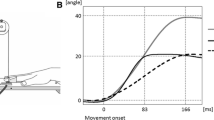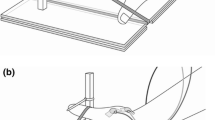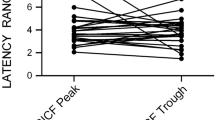Abstract.
Rapid angular displacements of the wrist evoke cerebral potentials that precede the onset of the long-latency electromyographic (EMG) activity generated in muscles stretched by the displacement. The initial segment of the long-latency EMG activity (termed the M2 response) is thought to be mediated by a transcortical reflex. We used dipole source analysis to examine the source generators of the early components of the cerebral potentials and their relationship to the timing and magnitude of the M2 response. Subjects (n=10) were presented with instructions to either actively flex or extend the wrist in response to a torque motor-imposed extensor displacement or allow the wrist to be passively extended. Electroencephalographic (EEG) recordings were obtained from 32 scalp-surface electrodes, and EMG was recorded from the wrist flexors and extensors. For all three tasks, the M2 response was preceded by cerebral potentials that could be explained by a three-dipole model. One source generator localised to deep within the cerebrum, and the other two localised to the region of the contralateral sensorimotor cortex. We used the P20-N20 dipole evoked by electrical stimulation of the median nerve at the wrist, corresponding to synaptic activity within cortical area 3b, as a local spatial reference to examine the contributions of the pre- and postcentral cortex. This analysis showed that one of the sensorimotor dipoles was consistently located anterior to the P20-N20 dipole at a displacement (average 11.5 mm) appropriate for a generator originating within the deep layers of area 4 on the anterior bank of the central sulcus. The orientation of this dipole was also consistent with a precentral generator and not a reversal of the potentials generated by input to area 3b. The time course of the area-4 dipole moment (onset =35 ms, peak =54 ms) was appropriate to reflect synaptic activity onto corticospinal neurons whose descending volleys mediate the M2 response. Comparisons across tasks showed that the magnitude of the M2 was modulated with task instruction, being largest with active and smallest with passive resistance. In contrast, the magnitude of the early evoked potentials (up to 75 ms) did not grade across tasks. We interpret these results as suggesting that instruction-dependent modulation of the M2 response occurs downstream from inputs to the primary motor cortex.
Similar content being viewed by others
Author information
Authors and Affiliations
Additional information
Electronic Publication
Rights and permissions
About this article
Cite this article
MacKinnon, C., Verrier, M. & Tatton, W. Motor cortical potentials precede long-latency EMG activity evoked by imposed displacements of the human wrist. Exp Brain Res 131, 477–490 (2000). https://doi.org/10.1007/s002219900317
Received:
Accepted:
Published:
Issue Date:
DOI: https://doi.org/10.1007/s002219900317




